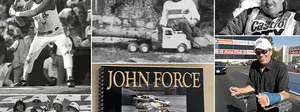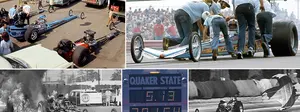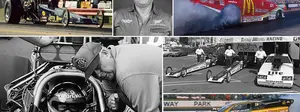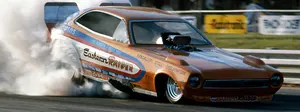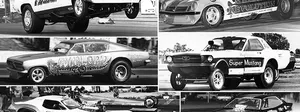

That was then, this is now
 |

Coming or going, you can nitpick the differences between the original, as shown in the first and third photos supplied by Bob Snyder and shot at the 1970 AHRA Summernationals at New York National Speedway, and the restoration and re-creation of the current car, but to me, it's still a beautiful sight.
|
 |
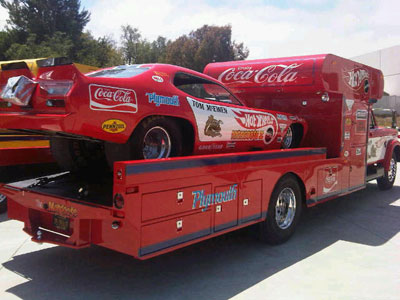 |
Reaction to my unveiling here of photos of the restored red Hot Wheels ramp truck was a real mixed bag, with enthusiastic thumbs-up for the primo job that Don Prudhomme’s Willie Wolter-led troops did to resurrect the iconic hauler and bedazzlement, bemusement, bewilderment, and begrudgement for the matching Funny Car, which clearly is not an original.
To the credit of the Prudhomme team, it has never once claimed that the McEwen Duster is original in any way and has acknowledged that it was put together solely as a prop for display during the 35th anniversary Hot Wheels celebration. The car, which has been on display several times with blue paint, does not run, and, by comparing the chassis in the then-and-now Hot Rod magazine cover pose, it’s clearly not period-correct.
Unlike the painstakingly visually and technologically accurate 'Cuda that rides on the yellow Prudhomme hauler, for all intents and purposes, the red car is window dressing for the red truck, a prop that rounds out the display. I'm not going to hold anyone's feet to the fire over that.
Skip Allum was emphatic in that point, noting that “the truck is the original piece, and that was the focus of the restoration effort. Then, rather than put a blue-bodied FC on the back of a red truck, we simply painted the blue body red. As it is not an original car and only a prop/show car originally put together by Mattel for photo ops for the 35th anniversary, we did not see any value in the expense of making it perfect."
SoCal veteran racewatcher Cliff Morgan was among those who spied the differences. “Couldn't help but notice what a difference there is between the ‘new’ car and the car shown on the Hot Rod cover,” he wrote. “The chassis, engine, headers, no scoop on the injectors on the original car, and the original body looks like it has a chrome bumper on it. The ‘new’ car looks like a modern chassis, and I'd think it would be legal to run today. Really interesting to me to see how much of a difference there is between the old and restored.”
For the record, the original chassis on the red car, like “Snake’s” yellow 'Cuda, was done by Ronnie Scrima at Exhibition Engineering, and the chassis for McEwen’s subsequent blue Duster was a John Buttera creation.
Roger Beard thinks that the whole project is still a home run, noting that even the newer Duster looks better than today’s “wedge-shaped things with the upside-down fishbowl for a roof and that big ugly box on the rear deck."
Added Don Thomas, “It's great, but at the same time, it's a little disappointing for me. The car is newer, and being the diehard ‘Snake’ and ‘Mongoose’ fan that I am, you can definitely tell. It looks killer, but the body and chassis is of the newer-breed style, and to me, it kinda takes away from the concept a bit. How cool if they could have somehow found and restored the '70 Duster as they did the 'Cuda. Oh well; it's there in spirit at least. Hats off to the ‘Snake’ team. They did a fine job considering what they had to work with. OK, 'Snake,' now replicate the black Hot Wheels 'Cuda!”
Bruce Dyda of Dyda Race Engineering, whose work includes the restoration of the Jim and Alison Lee Great Expectations II; Poachers; Blood, Sweat & Nitro; and other dragsters and the Tommy Ivo Showboat repop, lauded the team’s effort on the truck but called the Funny Car “the worst representation of a famous F/C I have ever seen.” It’s understandable that, in his line of work, the bar is set a little higher than the average fan’s expectations.
 |

Shots of the original (above) being loaded on the truck and the "new" car (below) show some differences, as pointed out by our readers.
|
 |
Sharp-eyed Michael Ostrofsky spotted something worth mentioning: “On the repainted 'Mongoose' Funny Car, the lettering on the side says Mongoose II, which was the blue version of the car, not the red. If you think of it, can you ask why the paint was done that way? Pretty amazing restoration project. Those rigs and cars belong in the Smithsonian.”
Unfortunately, the Prudhomme guys are out of the shop until after the Fourth, so I don’t have an answer, but Michael is absolutely right. The red Dusters (of which there were two; hence the Duster II denotation above the front wheelwell), as you can see in the photos running down the side of this column, supplied by the prolific Bob Snyder, did not say Mongoose II. My guess would be one of two things – and forgive me “Snake” team if I’m wrong – that either, to save time perhaps, the white area was masked off while the rest of the car was painted from blue to red, or, if new decals were made (assuming that this is vinyl and not paint), they used what was on the blue car as a model.
(You can see the differences in other areas. On the original, the inverted Federal-Mogul triangle and Cragar logos are under the white "Mongoose" billboard, but on the new car, they're between the billboard and the front fender, as they were on Mongoose II, and also the relative position of the Mongoose character, forward in the original, reaward in the new car)
Prudhomme’s 'Cuda also had two versions – the Exhibition Engineering car that is in his collection and then a Buttera chassis in late 1970 – and followed the same path as McEwen’s car in that it was again painted like its predecessor (yellow). That car became Snake II when it was repainted white with red flames (with current-year grille and taillights) for the start of the 1971 season. Snake III is the black car that Thomas references, run in gel coat at the end of the 1972 season (including The Last Drag Race at Lions; it later became the Careferee Gum car that won Indy in 1973).
I’m doubtful that the original McEwen Dusters (any version) still survive, and I’ve never heard what became of the wicked black 'Cuda.
All niggling aside, I still think that new addition to the "Snake” collection looks fabulous, and I’m sure that when presented together, the stark beauty and nostalgia value of seeing the rigs side by side far outweigh any historical imperfections.
























